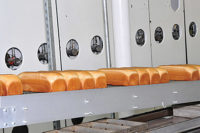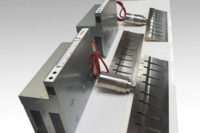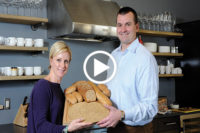In 1928, Rohwedder brought his bread slicing machine to be exhibited for the first time at a bakery trade fair in the United States. Sliced bread also started being sold and advertised, and the Rohwedder slicer enjoyed its first commercial use on record by the Chillicothe Baking Co., Chillicothe, Mo. The bakery’s product was called “Kleen Maid Sliced Bread,” which became a success. And as the bread slicing machines were gaining in popularity; so did the electric pop-up toaster.
Chillicothe Baking Co. produced its first bread slices using the machine in July of 1928. The use of commercial bread slicers for large-scale applications continued to grow as the slicers began being marketed around 1930. Three years later, nearly 80% of the bread sold in the United States was pre-sliced and wrapped. Thus, the phrase, “best thing since sliced bread,” was coined and so far hasn’t left the vernacular.
Scientists, meanwhile, had identified the benefits of whole meal flour in bread, but this had little effect at the time on the country’s significant preference for white bread.
In 1929, William Long was distributing The Round Table table books for bakery engineers, which featured articles including “Modern Bakery Construction,” which gave bakers hints on how to build or remodel their facilities. “The process steam and heating requirements for a new bakery depend on the size of the plant to be serviced and also, as far as the process steam is concerned, on the type of equipment to be used,” says the article, written by C.A. Taylor. Good advice. “We know, of course, that all bakers recognize the importance of ventilation in the oven room and baking portions of their shops, which must be carefully looked into when laying out the building,” the article goes on. “The ventilation of the flour storage is also important and can be taken care of by the proper use of ventilators…”
Back then, Holsum Cakes’ Orange Blossom cake, “made famous in sunny California,” was all the rage. Honolulu Moon, another new Holsum cake was described in ads as being made from a famous recipe of American planters, and was promoted as a “new treat from far off Hawaii.”
Tough times ahead
As the gaiety of the 1920s was ending, the stock market crashed, and millions lost all of their investments, savings and jobs. The banking and financial collapse in the fall of 1929 soon became the Great Depression, a devastating period. Bakers suffered many hardships, but didn’t all lose their businesses. Demand for baked items and bread dropped but didn’t disappear. Some bakeries, such as Gonnella, allowed local residents to use their ovens to bake their breads at little or no cost.
The Depression brought a tremendous decline in business, prices, bread wares and more unfortunately, painted a gloomy scene. Then came the passage of the Agricultural Adjustment Act and the National Industrial Recovery Act. Bakers struggled to comply with government regulations and for the very first time in this country, bread was taxed indirectly with a processing tax on wheat, says the AIB’s 1969 Annual Report.




















